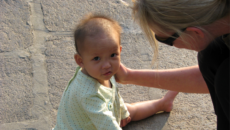Brittany, age 11, likes clothes, slumber parties, and keeping secrets with special friends. She is a typical pre-teen, except for one important difference. She is a foster child, soon to move to a new adoptive home away from friends and familiarity.
Brittany is one of hundreds of pre-adolescent children, who, because of new adoption laws, is moving more quickly from foster care to adoption. She is being placed across county and state lines, away from the people and things she felt most connected to. How can Brittany’s adoptive parents help her — and themselves — adjust as they open their hearts and home to her?
1. Maintain Contact Post-Placement
Continued post-placement contact with significant people will ease Brittany’s transition. Occasionally adoptive parents and social workers agree that cutting off all contact and quickly disengaging a child from his or her “foster care past” will facilitate adjustment. However, children this age form significant attachments to adults and peers. Abrupt disengagement is never emotionally healthy.
2. Expect Effects on School Performance
When older children move into adoption, they are not just getting new parents and a new home. The “new” list includes new friends, new school, new teachers, new rules, new books, and new procedures. And they are experiencing all this newness under the shadow, most likely, of some level of grief for what they have lost.
A potential short-term effect for some children is inattentiveness in school, even for the most successful students. Grades and behavior both suffer as youngsters adjust. To fit in, some become hypervigilant, watching for and attempting to learn the new “cues” from the environment. Academic success is not a high priority to them at this time.
3. Understand Loyalty Issues When Adopting Older Children
Brittany’s parents need to help her realize that she can love both sets of parents — her former foster parents and them as well. Early on she will get the message from her new family whether it is “okay” or “not okay” to talk about the other family — what they did and how they did it. The message may come in subtle ways. Brittany’s parents need to allow her to say such things as “My other mom did it this way,” without feeling threatened. If they respond by saying something like, “Well, in this house, we do it this way,” they will devalue not only her feelings of loss but her former relationship as well and set up barriers to adjustment for everyone. Asking questions about special memories with the former foster family, having a picture of that family in a visible place and bringing them up occasionally will model acceptance and encourage growth in trust and attachment to the new family.
4. Minimize Embarrassment
Although Brittany may be happy to have a family, being adopted may also invoke strong feelings of embarrassment and self-consciousness. Children Brittany’s age value sameness. They do not want to be different from their peers. If the placement is transcultural, everywhere they go with the family it feels like everyone knows “their” business. One youngster said, “We eat out a lot and every time I walk into a restaurant with my parents, it feels like people know my business right away. It is obvious that I wasn’t born to them. People sometimes ask questions that make me feel very embarrassed.”
Giving their new child the skill to answer intrusive and embarrassing questions is critical. When Peter, a handsome, bi-racial, eleven-year-old boy, was playing with his siblings at a playground, someone asked him, “Why did your other family get rid of you?”
Fortunately, Peter had been prepared by his parents and simply replied, “We only talk about that kind of stuff at home.” That ended the questioning and gave Peter confidence in his ability to maintain his privacy.
Bringing older children into a family brings many joys and many challenges. Knowing ahead of time the potential issues and problems, and being prepared to deal with them sensitively and openly, increases the likelihood of successful parenting.



